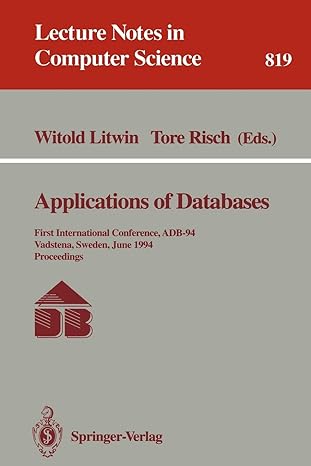Question
i cant figure out why my program is not working Minimum Spanning Tree: Solving TSP* for Metric Graphs using MST Heuristic Given an arbitrary metric
i cant figure out why my program is not working
Minimum Spanning Tree: Solving TSP* for Metric Graphs using MST Heuristic
Given an arbitrary metric graph, construct its Minimum Spanning Tree using Kruskal's algorithm. You can assume adjacency matrix representation of graphs. If you wish, you can reuse external libraries for heaps.
Now use the constructed MST to find an approximate estimate for the TSP problem. You can choose to implement any of the two approximation algorithms specified in Wikipedia's entry on TSP One with approximation factor of 1.5 (Christofides) or 2. Compare it with the optimal answer. You can use some external library to find the optimal solution to the TSP problem.
* TSP: Travel Salesman Problem
i got the c
#include #include #include
// a structure to represent a weighted edge in graph struct Edge { int src, dest, weight; };
// a structure to represent a connected, undirected // and weighted graph struct Graph { // V-> Number of vertices, E-> Number of edges int V, E;
// graph is represented as an array of edges. // Since the graph is undirected, the edge // from src to dest is also edge from dest // to src. Both are counted as 1 edge here. struct Edge* edge; };
// Creates a graph with V vertices and E edges struct Graph* createGraph(int V, int E) { struct Graph* graph = new Graph; graph->V = V; graph->E = E;
graph->edge = new Edge[E];
return graph; }
// A structure to represent a subset for union-find struct subset { int parent; int rank; };
// A utility function to find set of an element i // (uses path compression technique) int find(struct subset subsets[], int i) { // find root and make root as parent of i // (path compression) if (subsets[i].parent != i) subsets[i].parent = find(subsets, subsets[i].parent);
return subsets[i].parent; }
// A function that does union of two sets of x and y // (uses union by rank) void Union(struct subset subsets[], int x, int y) { int xroot = find(subsets, x); int yroot = find(subsets, y);
// Attach smaller rank tree under root of high // rank tree (Union by Rank) if (subsets[xroot].rank < subsets[yroot].rank) subsets[xroot].parent = yroot; else if (subsets[xroot].rank > subsets[yroot].rank) subsets[yroot].parent = xroot;
// If ranks are same, then make one as root and // increment its rank by one else { subsets[yroot].parent = xroot; subsets[xroot].rank++; } }
// Compare two edges according to their weights. // Used in qsort() for sorting an array of edges int myComp(const void* a, const void* b) { struct Edge* a1 = (struct Edge*)a; struct Edge* b1 = (struct Edge*)b; return a1->weight > b1->weight; }
// The main function to construct MST using Kruskal's algorithm void KruskalMST(struct Graph* graph) { int V = graph->V; struct Edge result[V]; // Tnis will store the resultant MST int e = 0; // An index variable, used for result[] int i = 0; // An index variable, used for sorted edges
// Step 1: Sort all the edges in non-decreasing // order of their weight. If we are not allowed to // change the given graph, we can create a copy of // array of edges qsort(graph->edge, graph->E, sizeof(graph->edge[0]), myComp);
// Allocate memory for creating V ssubsets struct subset *subsets = (struct subset*) malloc(V * sizeof(struct subset));
// Create V subsets with single elements for (int v = 0; v < V; ++v) { subsets[v].parent = v; subsets[v].rank = 0; }
// Number of edges to be taken is equal to V-1 while (e < V - 1) { // Step 2: Pick the smallest edge. And increment // the index for next iteration struct Edge next_edge = graph->edge[i++];
int x = find(subsets, next_edge.src); int y = find(subsets, next_edge.dest);
// If including this edge does't cause cycle, // include it in result and increment the index // of result for next edge if (x != y) { result[e++] = next_edge; Union(subsets, x, y); } // Else discard the next_edge }
// print the contents of result[] to display the // built MST printf("Following are the edges in the constructed MST "); for (i = 0; i < e; ++i) printf("%d -- %d == %d ", result[i].src, result[i].dest, result[i].weight); return; }
// Driver program to test above functions int main() { /* Let us create following weighted graph 10 0--------1 | \ | 6| 5\ |15 | \ | 2--------3 4 */ int V = 4; // Number of vertices in graph int E = 5; // Number of edges in graph struct Graph* graph = createGraph(V, E);
// add edge 0-1 graph->edge[0].src = 0; graph->edge[0].dest = 1; graph->edge[0].weight = 10;
// add edge 0-2 graph->edge[1].src = 0; graph->edge[1].dest = 2; graph->edge[1].weight = 6;
// add edge 0-3 graph->edge[2].src = 0; graph->edge[2].dest = 3; graph->edge[2].weight = 5;
// add edge 1-3 graph->edge[3].src = 1; graph->edge[3].dest = 3; graph->edge[3].weight = 15;
// add edge 2-3 graph->edge[4].src = 2; graph->edge[4].dest = 3; graph->edge[4].weight = 4;
KruskalMST(graph);
system("pause"); return 0; }
Step by Step Solution
There are 3 Steps involved in it
Step: 1

Get Instant Access to Expert-Tailored Solutions
See step-by-step solutions with expert insights and AI powered tools for academic success
Step: 2

Step: 3

Ace Your Homework with AI
Get the answers you need in no time with our AI-driven, step-by-step assistance
Get Started


